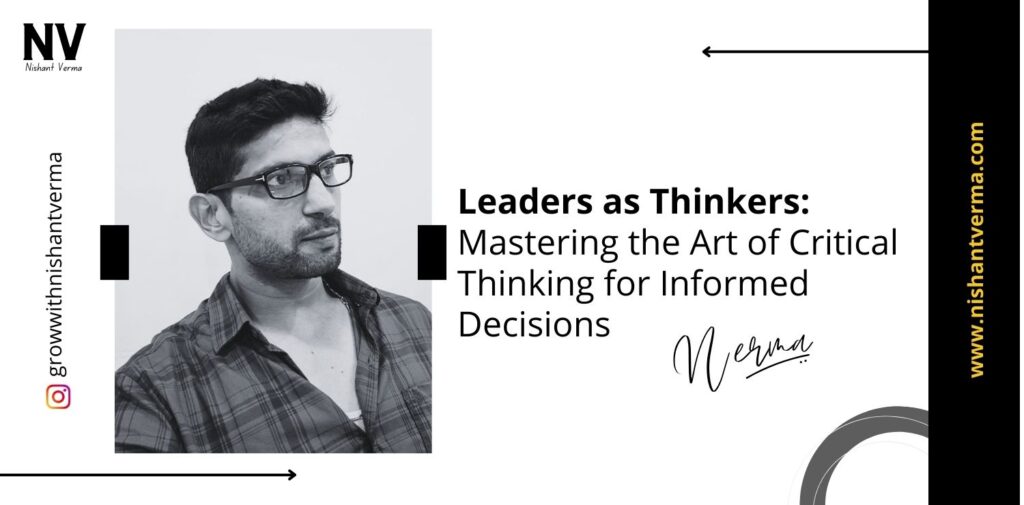Imagine leadership as a compass and critical thinking as the North Star guiding decisions. This article will explore the simple yet powerful concept of leadership and critical thinking, unraveling how leaders can cultivate this skill to make informed decisions. Join us on this journey of understanding the art of critical thinking and its role in effective leadership.

The Power art of critical thinking: Thinking in Leadership
Critical thinking is like a superpower that helps leaders navigate complex challenges. It involves analyzing information, considering different perspectives, and making sound decisions. Let’s explore why art of critical thinking matters for leaders in a simple way:
- Better Decisions: Critical thinking enables leaders to make well-informed decisions.
- Problem-Solving: Leaders use critical thinking to tackle problems and find effective solutions.
- Adaptability: It helps leaders adapt to changes and uncertainties with a flexible mindset.
The Role of Leadership in Fostering Critical Thinking
Leaders are like coaches, nurturing art of critical thinking skills in their teams. Here’s how leaders contribute:
- Setting Expectations: Leaders communicate the importance of critical thinking within the organization.
- Providing Guidance: Leaders guide team members on how to approach problems critically.
- Encouraging Questions: Creating an environment where asking questions is welcomed fosters critical thinking.
Critical Thinking Defined: Breaking it Down
Art of critical thinking is not a mysterious concept. Let’s simplify it:
- Analysis: Breaking down information into parts to understand it better.
- Evaluation: Assessing the credibility and relevance of information.
- Problem-solving: Using logical reasoning to find solutions.
- Decision Making: Making informed choices based on thoughtful analysis.
The art of critical thinking Process: A Step-by-Step Guide
Navigating the critical thinking process is like following a roadmap. Let’s break it down into simple steps:
- Identify the Problem: Clearly define the issue or challenge at hand.
- Gather Information: Collect relevant data and information.
- Analyze Information: Break down the information into meaningful parts.
- Develop Solutions: Generate potential solutions based on the analysis.
- Choose the Best Solution: Evaluate and select the most effective solution.
- Implement the Decision: Put the chosen solution into action.
- Evaluate the Outcome: Reflect on the results and learn from the experience.
The Connection Between Critical Thinking and Emotional Intelligence
Emotional intelligence is like a companion to the art of critical thinking. Leaders can combine these skills by:
- Self-Awareness: Understanding one’s emotions and how they may influence decision-making.
- Empathy: Considering the perspectives and emotions of others in the decision-making process.
- Self-Regulation: Controlling emotional responses to think rationally and objectively.
Types of art of critical thinking in Leadership: Recognizing Diversity
Critical thinking comes in various forms. Recognizing these types helps leaders apply the right approach:
- Analytical Thinking: Breaking down complex issues into manageable components.
- Creative Thinking: Generating innovative and out-of-the-box solutions.
- Open-Minded Thinking: Considering different perspectives and being receptive to new ideas.
The Impact of Cognitive Biases on Critical Thinking
Cognitive biases are like roadblocks to clear thinking. Leaders can overcome them by:
- Awareness: Recognizing and acknowledging personal biases.
- Seeking Diverse Perspectives: Actively seeking input from people with different viewpoints.
- Fact-Checking: Verifying information to ensure accuracy.

Developing Critical Thinking Skills in Teams: A Leader’s Guide
Leaders can nurture art of critical thinking skills in their teams by:
- Training Programs: Providing workshops and training sessions on critical thinking.
- Encouraging Discussion: Creating an open environment for team members to share ideas and perspectives.
- Assigning Challenging Tasks: Offering tasks that require analytical thinking and problem-solving.
Case Studies: Real-Life Examples of Critical Thinking in Action
Let’s draw inspiration from real-life leaders who applied art of critical thinking effectively:
- Leader A: Faced with a challenging market shift, Leader A analyzed industry trends, gathered insights from diverse team members, and made strategic decisions that positioned the company for success.
- Team B: Team B, guided by a leader who encouraged creative thinking, developed a groundbreaking product that exceeded customer expectations.
- Organization C: Organization C, facing a crisis, relied on leaders who employed analytical thinking to assess the situation, make swift decisions, and navigate successfully through the challenges.
Overcoming Challenges in Critical Thinking: Strategies for Success
Challenges in critical thinking are like puzzles waiting to be solved. Leaders can overcome them with strategies such as:
- Continuous Learning: Staying informed and updated on industry trends and developments.
- Collaboration: Seeking input from team members with diverse perspectives.
- Reflection: Taking time to reflect on decisions and learn from experiences.
Critical Thinking in Decision-Making: A Dynamic Duo
Critical thinking and decision-making go hand in hand. Leaders can enhance decision-making by:
- Considering Alternatives: Exploring different options before making a decision.
- Evaluating Risks: Assessing potential risks and benefits associated with each decision.
- Long-Term Impact: Thinking about the long-term consequences of decisions on the organization.

Critical Thinking in a Digital Age: Navigating Information Overload
In the digital age, leaders need to navigate information overload by:
- Source Verification: Ensuring the credibility of online information.
- Filtering Relevant Information: Focusing on what is essential for decision-making.
- Technology Utilization: Leveraging digital tools for efficient information analysis.
The Ethical Dimension of Critical Thinking: Making Morally Sound Decisions
Ethics is like the compass guiding art of critical thinking. Leaders can make morally sound decisions by:
- Considering Stakeholders: Thinking about the impact of decisions on various stakeholders.
- Aligning with Values: Ensuring decisions align with the organization’s values and principles.
- Ethical Dilemma Discussions: Facilitating open discussions about ethical dilemmas within the team.
Measuring the Impact of Critical Thinking: Metrics Simplified
Metrics are like indicators showing the effectiveness of the art of critical thinking. Simplified metrics for measuring the impact include:
- Decision Accuracy: Assessing the accuracy of decisions made through critical thinking.
- Problem-Solving Efficiency: Measuring the time it takes to solve complex problems.
- Innovation Output: Evaluating the number and quality of innovative solutions generated.
Conclusion: Architecture of leadership for Informed Decision-Making
In the grand architecture of leadership, leaders are the architects of informed decision-making, with critical thinking as the cornerstone. As architects of informed decisions, leaders can guide their teams with clarity, wisdom, and a strategic mindset. Let’s build workplaces where the art of critical thinking is not just a skill but a mindset and where every decision is a testament to thoughtful analysis, creativity, and a commitment to success.




